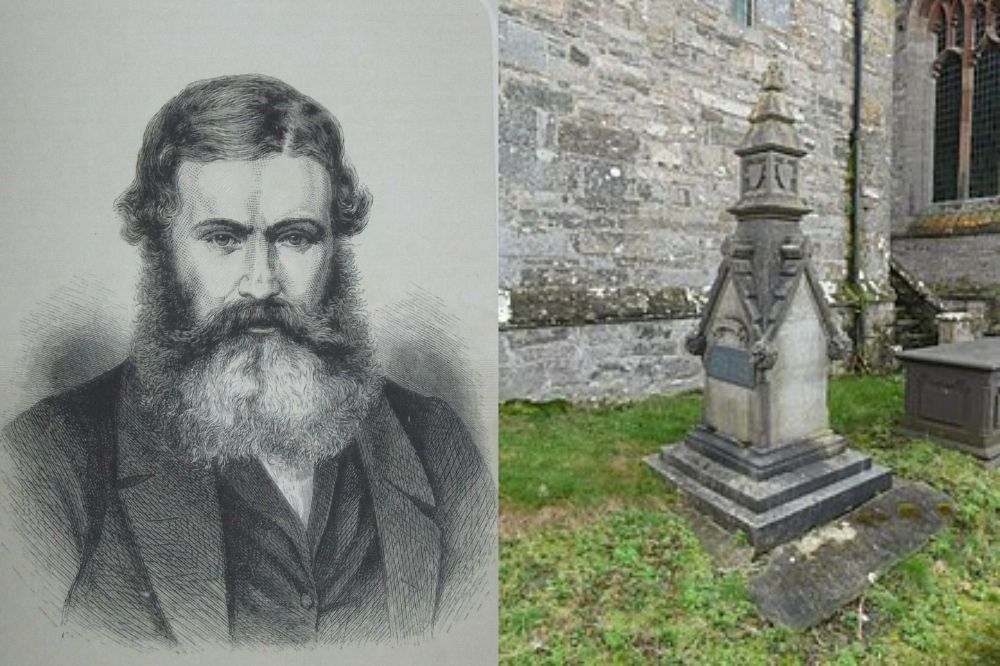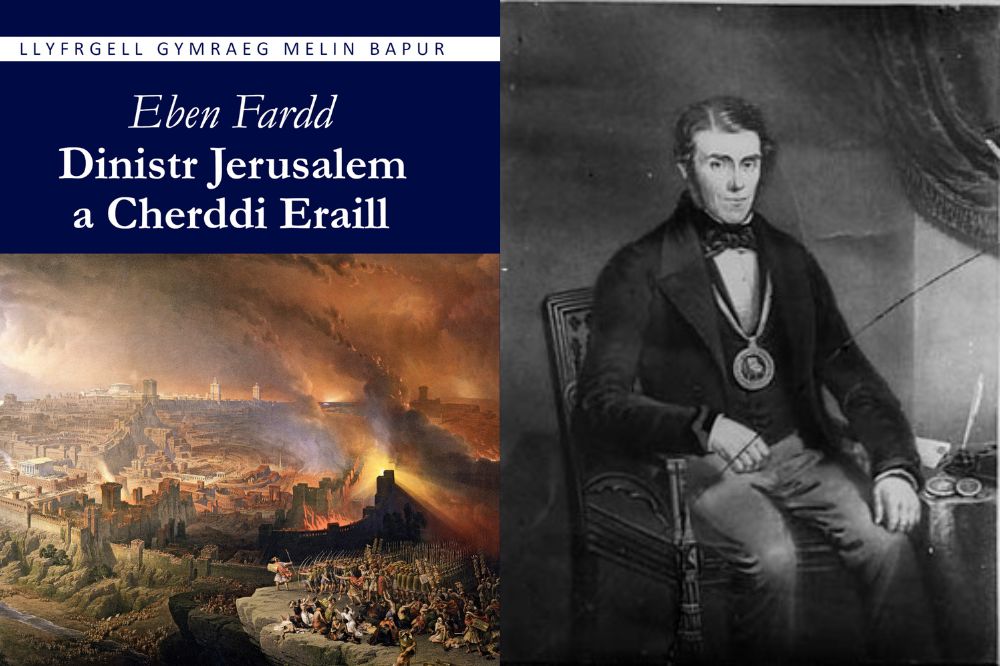The Grand Old Man of Cynghanedd

Adam Pearce Editor, Llyfrau Melin Bapur
Whilst some aspects of the Welsh Eisteddfod tradition have their roots in the middle ages, it was only at the end of the eighteenth century that Eisteddfodau as we know them today – cultural festivals and celebration of Welshness centred around creative competitions, anonymously judged – became a regular part of the cultural and social fabric of Wales.
Although the annual ‘official’ National Eisteddfod as it is now known didn’t start until 1860, many of the nominally “local” Eisteddfods arranged on an ad-hoc basis during the first half of the nineteenth century were major cultural events.
They were enthusiastically covered by the burgeoning Welsh press and drew competitors from all over Wales, providing an opportunity for poets to become truly national celebrities through their poetry in a way which had not previously been possible.
Eben Fardd
One of the most successful competitors at these early Eisteddfodau was Ebenezer Thomas (1802-1863), like many Welsh poets more widely known by his bardic name, Eben Fardd.
He would become one major poets of the century in Welsh, and a new volume of his poetry is the latest instalment in Melin Bapur’s ongoing Llyfrgell Gymraeg series which aims to ensure the classics of Welsh literature are available to modern readers.
A native of Llangybi in Gwynedd, Eben Fardd lived for most of his life in the village of Clynnog and was one of the last and greatest of a group of poets associated with Eifionnydd around the turn of the nineteenth century.
His talent for poetry was obvious even in his teens, and his first of many successes came in 1824 when he won the Chair at the Powys Eisteddfod for his awdl on Dinistr Jerusalem (the Destruction of Jerusalem).
Though he was just 22 at the time – some even whispered that such a young man could not have been the true poet and spread (entirely groundless) rumours of foul play – Dinistr Jerusalem would prove to be his most famous poem.
Depicting the brutally violent Siege of Jerusalem by the Romans in 70CE, the poem remains remarkably fresh and powerful today thanks in no small part to the poet’s discipline in maintaining conciseness, a tight structure, and restricting himself to a descriptive mode without resorting to moralising and preaching.
The horrific images are allowed to speak for themselves:
Llithrig yw’r palmant llathrwyn
Môr gwaed ar y marmor gwyn.
(The glorious white pavements slippery
A sea of blood on the white marble)
Acclaim
Dinistr Jerusalem is often cited as one of the finest long poems of the nineteenth century in Welsh and one of the finest examples of an Eisteddfod awdl of its period, perhaps, indeed, the earliest great awdl written for an Eisteddfod competition.
Anyone interested in cynghanedd or in the history of Welsh poetry more generally will want to read this wonderful poem, which is one of three of Eben’s awdlau included in this volume, the others being his unsuccessful entry on the sinking of the Rothsay Castle for the Beaumaris Eisteddfod in 1832 – another fine descriptive awdl in a similar neoclassical vein – and his successful awdl on Brwydr Maes Bosworth (The Battle of Bosworth Field) of 1858, of which more is written below.

Whilst the Eisteddfod provided Eben Fardd with the impetus for his best known large works he was also a fine poet on a smaller canvas, and in his shorter poems in both strict and free metres can be seen some of the earliest steps by a Welsh poet into the Romanticism which would be the dominant aesthetic of Western art.
Here’s an example from poem not in cynghanedd, Myfyrdod ar Lan Afon (Meditations on a Riverbank):
Rwy’n teimlo gradd o bruddder, er yn iach,
Wrth weld dy ddiwyd hynt, afonig fach,
Myfyrio’r wyf am amser, fel y rhed,
Heb orffwys ennyd, mwy na’r llif ar led:
Trawiad amrant ei fyrhau a wnâ
A f’einioes wywa fel blodeuyn ha’;
Meirch ydynt fuain, buan yw y gwynt
Ond wele einioes dyn eheda’n gynt!
(I feel a degree of melancholy, though I am healthy
To see your busy path, little stream;
I’m meditating on time, and how it flows
Without a second’s rest, more than the river’s spread
A blink of an eye makes it shorter still
And my own life withers like a summer flower
Horses are swift, swift blows the wind
And yet, see how man’s life flies faster still!)
Fine as some of these pseudo-Romantic poems are, one has a sense that Eben’s natural talent was better suited to the neoclassical, descriptive vein; and it was in this mode that he wrote a number of fine poems like Eifionydd and Molawd Clynnog praising his native Eifionydd.
He was also a fine writer of hymns in the Methodist tradition, some of which remain familiar to congregations today including his best-known, Crist yn Graig Di-Sigl (also known by its opening line, O fy Iesu Bendigedig), believed to have been written following the deaths of his wife and two of his children within a short period in the 1850s.
Eisteddfodau
The Eisteddfodau clearly remained the main focus of Eben’s poetic efforts however.
His later competition poems lack the discipline of his first great masterpiece; nevertheless he would taste success again with yet another awdl, Job in 1840, by which point he could lay as strong a claim as any to be Wales’ best known, most successful and most influential living poet.
He was much in demand as an Eisteddfod adjudicator, in which capacity he was regarded as a fair and capable judge and frequently credited with raising poetic standards, though he was also involved in some contentious decisions.
By his later years he had become something of a Grand Old Man of Welsh poetry, mentoring younger poets like Talhaiarn (whose 1849 Aberffraw Eisteddfod awdl Eben had criticised so sternly that, allegedly, the younger poet tore the manuscript to shreds on the stage).
This role perhaps suited him well, given that his day-job was as schoolteacher (another poem, Ffarwel Athro Afaon i’w Ddisgybl, depicts a teacher’s fond farewell to his favourite pupil).
Perhaps his most influential poem of all – for better or worse – was the long pryddest of 1850 on Yr Atgyfodiad (The Resurrection), a deliberate attempt to realise Goronwy Owen’s dream of a Miltonic Christian Epic in Welsh.
The poem is sadly mediocre, but was enormously popular and spawned dozens of emulations, many much worse, over the next half century.
Welsh oppression
Eben was to taste Eisteddfod success a final time with his 1858 awdl on Brwydr Maes Bosworth (the Battle of Bosworth Field).
Despite some fine sections it does not approach his earlier work from a poetic standpoint; nevertheless it provides a fascinating insight into Welsh historiography and the way the Welsh conceived of themselves in the Victorian period.
The poem begins by placing the battle within a narrative of historic Welsh oppression through the ‘brut’ (a combination of history and prophecy) of a druid which speaks of the eventual victory of the (in)famous Mab Darogan (Son of Prophecy) clearly identified in the poem as Henry Tudor (“Cymro da o waed cyfa’ coch!” / A good Welshman of wholly red blood!).
The battle itself, and the mighty feats of Henry and the other Welsh on the battlefield are described, and the poem ends with a pean to Queen Victoria, claimed as Welsh, via her Tudor ancestry).
This ‘British Welshness’ is emblematic of the way so many prominent Welsh cultural figures in the nineteenth century saw no contradiction between a patriotic Welsh identity and an often fierce loyalty to the British state.
Whilst there is no doubt this will seem contradictory to most today, it nevertheless remains a fascinating example which historians (whatever their view) will want to explore.
Whilst his overall poetic output is somewhat uneven, particularly from his later years; and though his name may not be as familiar as the poets who came after him, Eben Fardd is undoubtedly a major Welsh poet and this new collection is a selection of his finest work.
His poetry in the strict metres is particularly effective and he can lay as strong a claim as any to being the nineteenth century’s finest practitioner of cynghanedd: along with his famous awdlau there are many finely crafted cywyddau and englynion.
All students of Welsh literature, history or culture will want to examine this fascinating figure in more detail.
Dinistr Jerusalem a Cherddi Eraill by Eben Fardd is available now from www.melinbapur.cymru and from all good Welsh bookshops, priced at £7.99+ P&P.
Support our Nation today
For the price of a cup of coffee a month you can help us create an independent, not-for-profit, national news service for the people of Wales, by the people of Wales.




